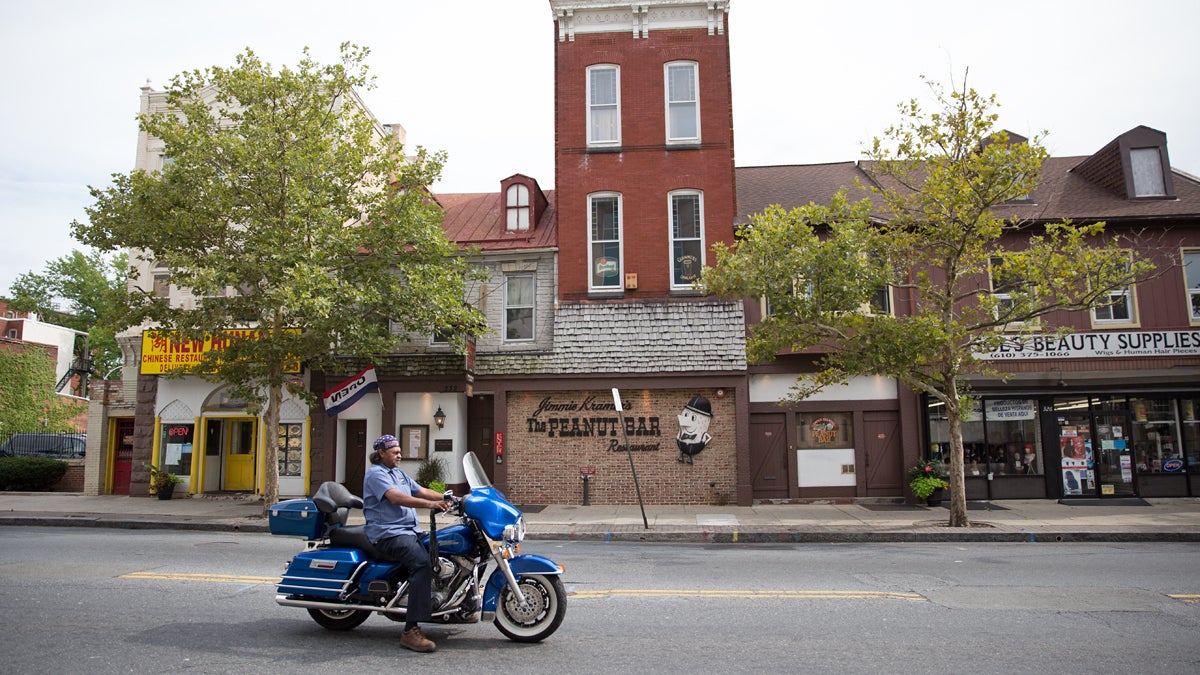Reading receives national recognition for ‘complete streets’ policy

Reading received a perfect score for its complete streets policy in 2015 by Smart Growth America. (Lindsay Lazarski/WHYY)
The city of Reading was one of 16 U.S. cities recognized by Smart Growth America (SGA) recently for creating exemplary ‘complete streets’ policies in 2015.
The city of Reading was one of 16 U.S. cities recognized by Smart Growth America (SGA) recently for creating exemplary ‘complete streets’ policies in 2015.
‘Complete streets’ policies aim to accommodate all street users, whether they travel by car, bus, bicycle, or on foot, through design choices that clarify where everyone belongs. There’s a gradation of complete street designs, from basic elements like sidewalks, crosswalks, and “Share the Road” markings, to more substantial features like physically separated lanes for transit vehicles and bicycles, or traffic signal priority for pedestrians and transit.
Reading was actually the first city to ever score a perfect 100 from SGA, which advocates for policies that promote traditional urban infill development over suburban land use planning.
What led to the perfect score?
SGA says Reading’s policy went “beyond a vision for complete streets to clearly commit to building an integrated, context-sensitive transportation network.”
It includes a list of performance measures, which the city will evaluate projects on annually to chart their progress. The list is long but includes some of the following metrics:
Number of crashes and severity of injuries
Injuries and fatalities for all modes
Number of curb ramps
Number of countdown signals
Miles of accessible routes
On-time arrivals for BARTA (Berks Area Reading Transportation Authority)
Number of students who walk or bike to school
Commercial vacancies in downtown improvement district (DID)
Number of mode users: walk, bike, transit
Reading’s executive order also incorporates some non-transportation goals like green stormwater management, and makes aesthetics and placemaking a central focus. From the order:
“Complete Streets are beautiful, interesting and comfortable places for people. The design of cities begins with the design of streets, as community places where people want to be. As part of Reading’s public realm, streets shall be held to a higher standard for urban design at a human scale. Multi-modal accommodations and all City projects in the right-of-way shall be approached as opportunities to enhance the aesthetic qualities of Reading and its public realm through the thoughtful creation of place. Wherever feasible, streetscapes shall protect and include street trees and native plants, and incorporate landscape architecture, public art, pedestrian amenities and wayfinding signage, sidewalk cafes and street-facing retail, and/or other elements that enhance the attractiveness of Reading and foster healthy economic development.”
Craig Peiffer, zoning administrator for the city of Reading, said the policy was created through an executive order by former Mayor Vaughn Spencer in August of 2015, as part of an overall strategy to improve the city’s downtown business district. It continues to enjoy support from the new Mayor Wally Scott.
With support from the Berks County Community Foundation, the city hired a consultant to develop a complete streets mobility plan, and presented the recommendations to local stakeholders and officials in a day-long workshop which Peiffer still credits with getting city and county planners, political leaders, and members of the business community on the same page.
Peiffer says the purpose of the complete streets plan, in addition to creating safer conditions for pedestrians and cyclists, was to make downtown streets places more inviting for lingering and shopping.
“As you can imagine, the focus was on just the automobile, and primarily getting folks in and out of the city,” he said, “It wasn’t designed for the human scale.”
Now city staff evaluate street maintenance plans annually and look for opportunities to calm traffic and close gaps in the pedestrian and bicycle network, and they’ve already implemented some of the low-hanging fruit.
The city is currently working with the 18th Ward Oakbrook Neighborhood Development and Economic Development (WONDER) collaborative on a project combining green stormwater infrastructure with traffic calming changes, and bike and pedestrian improvements.
They’re also working with PennDOT to replace three state-owned bridges between Center City and West Reading, installing wider sidewalks, bike lanes, and protection from vehicle traffic. While some other cities sometimes report difficulty getting PennDOT to go along with changes to state routes that de-prioritize vehicle traffic, Peiffer said District 5 transportation planners were accommodating to a multi-modal approach.
“The only issue we ran into was that we didn’t want to plan a bike lane on a bridge with no connection on either side, so we’re going ahead with the bike lane on the bridge, and planning to install bike lanes on either side when we repave,” he said.
In addition to the complete streets program, Reading is also nearing passage of a comprehensive plan for the city, coming soon to City Council, which calls for an update to the city’s zoning ordinance.
Peiffer believes the time is ripe for updating the city’s building rules, given the large influx of new residents to the city in recent years, most of them Latino families from New York City, who have injected new life and small business activity into Reading’s downtown area.
WHYY is your source for fact-based, in-depth journalism and information. As a nonprofit organization, we rely on financial support from readers like you. Please give today.


